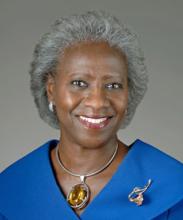
October, 2018
DR. VALANTINE'S FOOD FOR THOUGHT

Hannah A. Valantine, MD
Chief Officer for Scientific Workforce Diversity
This month, two outstanding women scientists won 2018 Nobel Prizes in science, but we recognize how much more work needs to be done to achieve inclusive excellence in science and medicine. Below, see what NIH and academia are doing to confront gender harassment in science - likely one of the factors holding women back. Also read a success story about building a community of diverse physician scientists through an integrated approach to diversity and inclusion. And more!
Science Faces its #MeToo Moment
This past summer, the National Academies issued an unsettling report on sexual harassment in academia, revealing that one-fifth of women undergrads and grad students experienced sexual harassment. The vast majority of incidents were gender harassment (watch 2-min video), not overt sexual coercion. Women in science experience subtle forms of sexism, known as microaggressions, every day – sending a not-so-subtle message that women do not belong in the lab. As noted in two recent editorials, the report’s conclusions point to the urgent need to close gaps between men and women in salary, career advancement, and leadership in biomedicine – and that solving the problem of sexual harassment will rely on institutions making it a priority and changing the culture of science. NIH is actively addressing this problem in multiple ways, including a first-of-its-kind scientific survey to be administered to all NIH staff to assess prevalence and identify workplace climate factors that are the harbingers of sexual harassment at NIH facilities. The results of this survey will guide interventions for NIH and NIH-funded institutions.
How to Attract and Keep Diverse Physician Scientists
What does it take to recruit and retain diverse physician scientists – a research population already in short supply? As we’ve shared in the past, several approaches are effective – especially if they are integrated, such as the NIH SWD Toolkit. Another good example is the University of Utah’s Center for Clinical and Translational Science. This program has created an inclusive environment with concrete, doable steps. These include training search-committee members to recognize implicit bias, establishing a standing salary-equity committee, and employing the Matrix Mentoring Model, which has led to greater inclusion of women and individuals from groups underrepresented among grant-funded investigators in the Utah research enterprise. Another key component is a holistic, cohort-based program of mentorship for clinical and translational scholars – similar to the NIH Distinguished Scholars Program. The Utah approach has built a community for diverse physician scientist investigators and an economy of scale for the institution.
Why My Mentor is Great
What does it take to be an excellent mentor? Being an excellent scientist, or being a patient listener? Offering career advice or being humble and empathetic? All of these, say several early-career scientists in a recent article, "NextGen Voices: Quality Mentoring." We know that mentorship – or lack thereof – can make or break a career. And mentors often pay it forward when it is their turn with trainees. A broad range of qualities describe a good mentor; in addition to those mentioned above, and in the article, are open communication, respect and trust, patience, and factors that relate to scientific problem-solving, career exploration, work-life balance, and more.
"Nobel Committee Reminds Nominators that Women Exist
This year, in October 2018, two women were awarded Nobel Prizes in science: NIH-supported chemist Frances Arnold (for her work on directed evolution of enzymes) and optical physicist Donna Strickland (for her work on generating laser beams with ultrashort pulses). Strickland, only the third woman in history to win the Physics prize, had remained relatively unknown and had in fact failed Wikipedia’s academic-specific notability test just months earlier when a Wikipedia user editor tried to create her entry before Strickland’s recent fame. In the awards’ history, women have won only 3% of the science-related Nobel prizes overall, and so for the first time, the Nobel Prize committee will explicitly call on nominators to consider diversity in gender, geography and topic for the 2019 prizes. The committee will also remind nominators that they can put forward names corresponding to three different discoveries (as well as multiple names for a single discovery), which is known to lead to an increased number of choices

The links above are pulled from the top news articles trending on the subject of diversity in science and technology.
The stories selected are not a reflection of the views of the National Institutes of Health.

